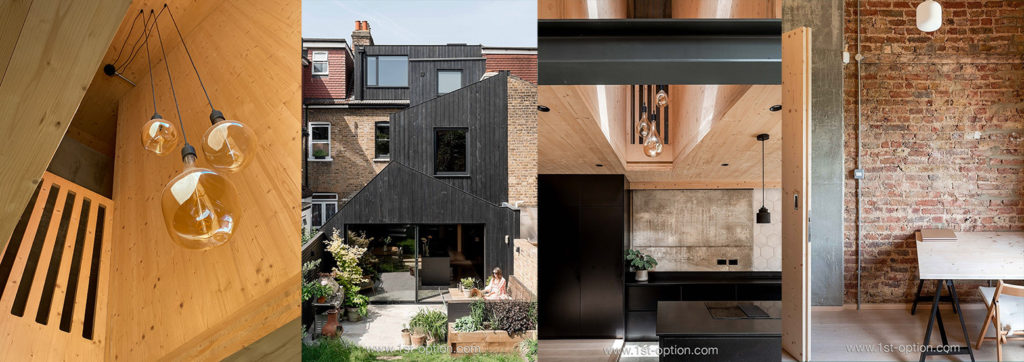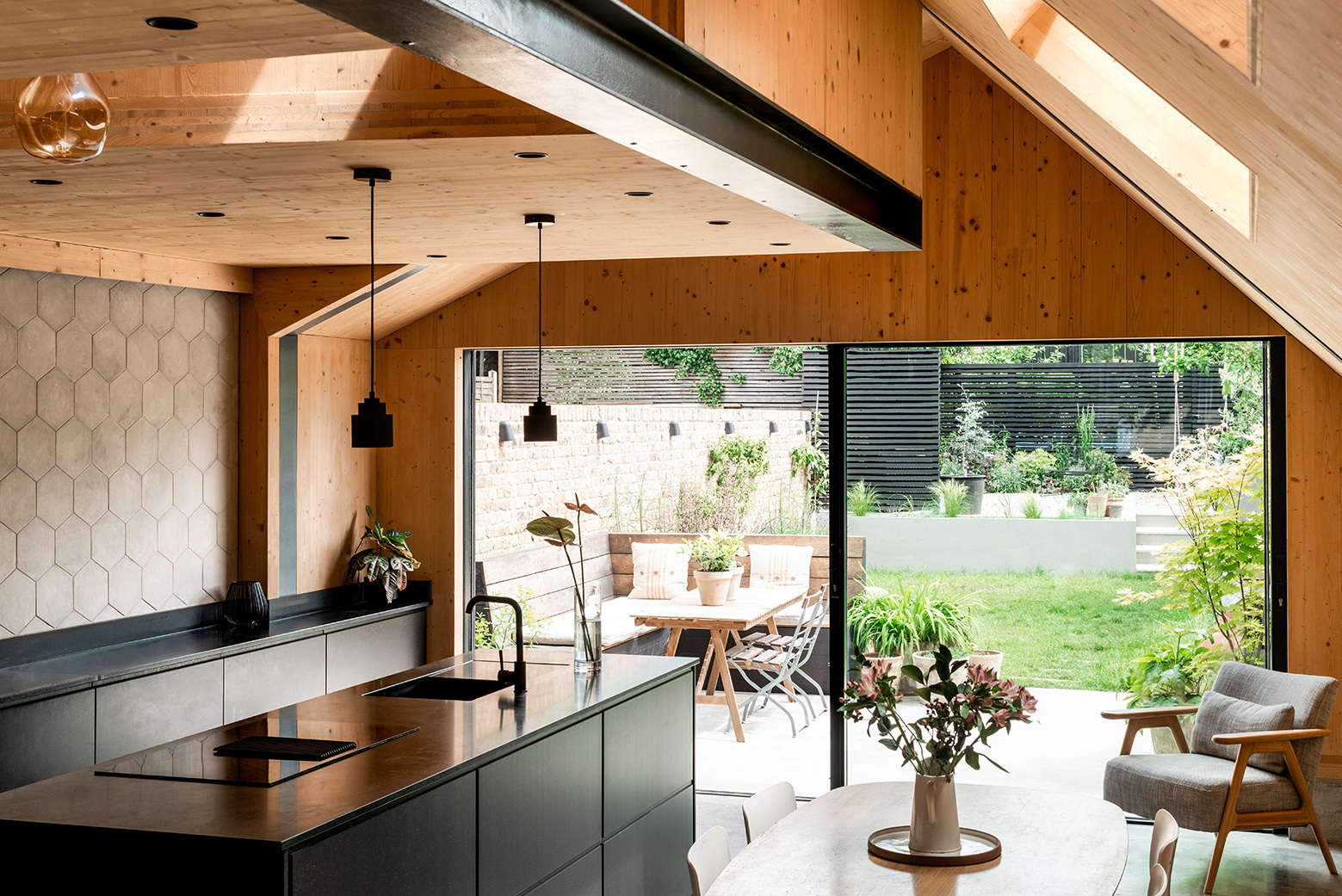Rob – “So, what would you say your design style is within this property?”
Mark – “That’s a good question. I guess the design style is… I mean it’s obviously influenced by modernism, I guess a little bit of brutalism also, with the concrete elements and obviously the Scandi/ Japandi thing is a big influence, as well as minimalism. Minimalism within the context of a family house, where we try to keep everything as sleek and tidy as possible.”

Rob – “And what were the influences within the design would you say?”
Mark – “I guess… well I mean obviously we’re not professional designers or architects, so you know, in terms of the big picture, it all came from the architect. The big design idea was building a cross laminated CLT extension. Once we established that as the envelope, we did a lot of visual research for what combinations would look good within that, and we really loved the contrast of the black kitchen units against the pale timber.”
“So yeah, the architect designed the inflow envelope and then really it was just a lot of visual research to hone down the interior style we were after. Looking at Pinterest (as everyone does), and all the visual resources that are out there for inspiration.”
“I think ultimately, the biggest influence on the style is a Scandinavian aesthetic because it’s pale timber, simplicity at its heart, simple furniture and is fairly utilitarian throughout.”

Rob – “Just touching on that – I personally really like the way you’ve got modern spaces, complementing the mid-century elements; it really works together so well.”
Rob – “Why did you decide on the architecture and the timber construction?”
Mark – “Well, when you first meet your architect, you want them to come back with some kind of big or bold idea that’s going to blow your mind; not some kind of identikit extension that you’ve seen before. So, when we first met our architect, Tom Gresford, at Gresford Architects, his big idea was effectively knocking down the rear of the house and rebuilding the kitchen upwards in a timber, CLT construction.”
“So, it was a fairly bold step to effectively demolish a third of our house – that we had just spent a lot of money on – but we knew we’d have a lot of building work anyway, so demolishing and starting again actually gave us the opportunity to do something a little different. When you look at the void, the sense of the house would only be possible by starting again and using a different form of construction. In the end it actually gave us a lot more flexibility to be nimble and more playful in terms of what we did with the back of the house, within the constraints of the footprint.”

Rob – “Amazing! What’s your favourite area within the house would you say then?”
Mark – “Ah, the kitchen! The kitchen’s got to be my favourite, closely followed by the seating area just outside the kitchen in the garden, where we do just spend a lot of time and entertain whenever possible (certainly in the spring and summer months). Everyone just loves it out there, as it’s near the kitchen, near the fridge, gets the sun in the morning and then by the time it hots up in the afternoon, it gets nice and shady. Just an amazing space to entertain!”
Rob – “I bet it’s been perfect this summer as well.”
Mark – “Yeah, it certainly has! Although too hot sometimes in the morning, because we haven’t built shade there, there’s shade at the back of the garden on the pergola, but it gets direct sun in the morning, so can get too hot when it’s beaming down. This might have to be something we think of in the future; build some shade there, or perhaps plant a tree or something.”

Rob – “I guess there’s always going to be things to add.”
Mark – “Yeah, exactly, well certainly the front of the house is the last bit to add, we’ve got plans for that, but it costs money. Hopefully we can get more bookings and the money can go into the front of the house fund.”
Rob – “Hopefully we can get them for you. So, you work on the other side of the camera, how did you get into the TV industry?”
Mark – “Ooh, that’s a good question. I started my career a long time ago, being a runner for a post-production company in Soho. I then worked my way up to an editor – cutting and editing factual programmes. I then moved across to become a director and producer in factual TV, which is where I am now. I don’t direct so much anymore, now working more as a producer for factual documentaries and series’ for UK and international broadcasters.”
“So yeah, that’s kind of how I got into it, like most people, I started at the bottom and found my way up. So, hopefully working in the industry gives me an appreciation of the needs of the client. For example, this property is on a very quiet street in a low traffic neighbourhood, so I know how important sound is a lot of the time when filming. Often when filming, sound is a crucial consideration – sometimes it’s something you can’t tell from the pictures, knowing whether the location is going to be noisy or not. But as this is a really quiet street, with quiet neighbours, actually as quiet as you’re going to get in London, it’s great for filming sound.”
“There’s also lots of on-street parking and nearby coffee shops, which I know are super important. We’re close to the tube station, so from all of those perspectives, we understand that those practical considerations can be just as important for the crews as the aesthetic ones.”

Rob – “Brilliant! You kind of touched on it, but how do you find working on the other side of the camera and being a shoot location owner?”
Mark – “I think because I’ve been a director and producer on the other side of the camera, I understand that when you hire a location, you do need full and complete access to the house. Because of that, as a location owner, you really do need to take a step back when you welcome the crew into your home. Make sure they have everything provided on hand. Answer any questions they may have, but then take a step back and let them do their thing. You have to let them bring their kit in, not be too precious about where they put things, because at the end of the day, they’re paying you to have the space for the day, so you have to get out the way and make yourself scarce.”
“I think I’ve got a pretty good understanding of that – it’s important that the crews feel welcome when they turn up and that you are able to give them the information they need and they don’t feel like they’re putting you out. Ultimately the client is paying for your property, and they know they’re paying for your inconvenience, so we try to make sure they don’t feel like that when they’re here. “It’s really important to us that clients are happy filming here, that they feel welcome and ultimately that they give good feedback from their experience filming with us.”
Rob – “I guess as well, having the industrial elements is quite handy for not being too precious with the house.”
Mark – “Yeah, 100%. I think there’s a lot of hard-wearing surfaces in the house; there’s concrete floors, wooden floors, timber walls. So the house is designed (well, you know it’s a family house), so it’s designed to withstand the rigours of family life – young kids and all that kind of stuff. While obviously crews generally take care to protect the floors, accidents can happen, so the house is perfect as it’s designed to be robust.”

Rob – “Yeah of course! So last question, what made you decide to become a shoot location owner?”
Mark – “Good question again, so when we set out to build this house, we set ourselves two goals, firstly we wanted to build something, design something that would be beautiful enough to be photographed and to be in the press. And you know, we’ve actually had some press recently; we’ve just recently been featured in Grand Designs Magazine and also in Dezeen. We were also nominated in the Waltham Forest Design Awards. Not that those things are important to us per se, but it was more a question of: let’s set ourselves that goal to design ourselves something that is of a standard that people would want to photograph it and nominate it for awards.”
“It’s a bar you set yourself, and obviously because we designed it to be beautiful – or at least what we think is beautiful – it actually lends itself quite well to being photographable and becoming a shoot location.”
“Being in the industry is obviously something I know about; I’ve hired various locations myself before for shoots, so I know it’s an option for homeowners and we think it’s a fun thing to do. It’s always really fun and interesting to welcome people into the house and to meet talented directors, art directors, actors, producers etc. There’s obviously a financial aspect, as well, which is not unimportant given we’ve made a large financial investment on the house.”
“So, partly it is also a way of recouping some of that financial investment that we’ve made, or certainly gaining a little bit of extra income that helps us to pay for holidays and things like that – so that is an important aspect.”
Rob – “Amazing Mark, that’s all from me and everyone at 1st Option. Thanks so much and see you all in the next one.”
